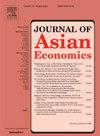A copula-based framework for studying intergenerational income mobility
IF 3.4
3区 经济学
Q1 ECONOMICS
引用次数: 0
Abstract
This study extensively elucidates the methodological advantages inherent in a copula-based framework for researching intergenerational income mobility: (1) By delving into copula density, one can shift the focus from a single summary index (such as the rank-rank slope or intergenerational income elasticity) to more nuanced mobility patterns that exhibit less sensitivity to marginal income distribution specifications. (2) With consistent marginal cumulative distributions, the framework enables the examination of changes in bivariate intergenerational income dependence, or morphology. This is achieved by assessing variations in copula density before and after accounting for relevant covariates, with the Cramér–von Mises statistic providing a user-friendly test for the statistical significance of these variations. (3) The copula-based framework, through the construction of different cross profiles on the copula density surface, accommodates research objectives related to both relative and absolute income mobility. To exemplify the application of this framework, we investigate intergenerational income mobility between 1978 and 2017 using the National Longitudinal Survey of Youth 1979 (NLSY79).
基于copula的代际收入流动研究框架
本研究广泛阐明了基于copula的代际收入流动研究框架所固有的方法论优势:(1)通过深入研究copula密度,人们可以将重点从单一的汇总指数(如等级斜率或代际收入弹性)转移到对边际收入分配规范不太敏感的更细致的流动性模式上。(2)在边际累积分布一致的情况下,该框架能够检验双变量代际收入依赖或形态的变化。这是通过在考虑相关协变量之前和之后评估联结密度的变化来实现的,cram - von Mises统计为这些变化的统计显著性提供了一个用户友好的测试。(3)基于copula的框架通过在copula密度面上构建不同的交叉剖面,可以同时满足相对和绝对收入流动性的研究目标。为了举例说明这一框架的应用,我们使用1979年全国青年纵向调查(NLSY79)调查了1978年至2017年的代际收入流动性。
本文章由计算机程序翻译,如有差异,请以英文原文为准。
求助全文
约1分钟内获得全文
求助全文
来源期刊

Journal of Asian Economics
ECONOMICS-
CiteScore
4.70
自引率
9.40%
发文量
90
期刊介绍:
The Journal of Asian Economics provides a forum for publication of increasingly growing research in Asian economic studies and a unique forum for continental Asian economic studies with focus on (i) special studies in adaptive innovation paradigms in Asian economic regimes, (ii) studies relative to unique dimensions of Asian economic development paradigm, as they are investigated by researchers, (iii) comparative studies of development paradigms in other developing continents, Latin America and Africa, (iv) the emerging new pattern of comparative advantages between Asian countries and the United States and North America.
 求助内容:
求助内容: 应助结果提醒方式:
应助结果提醒方式:


